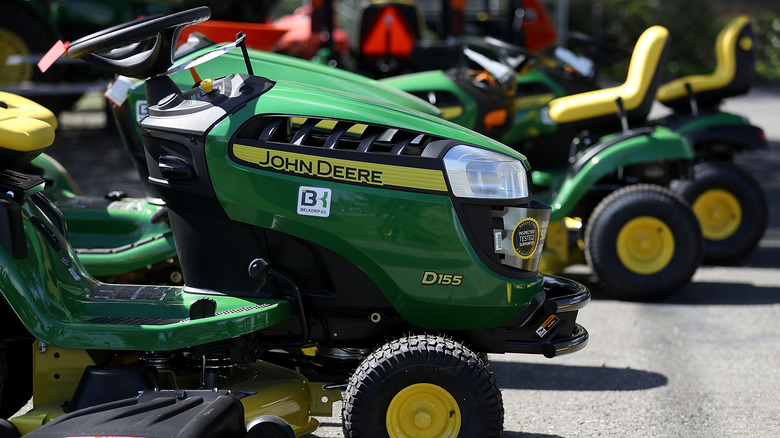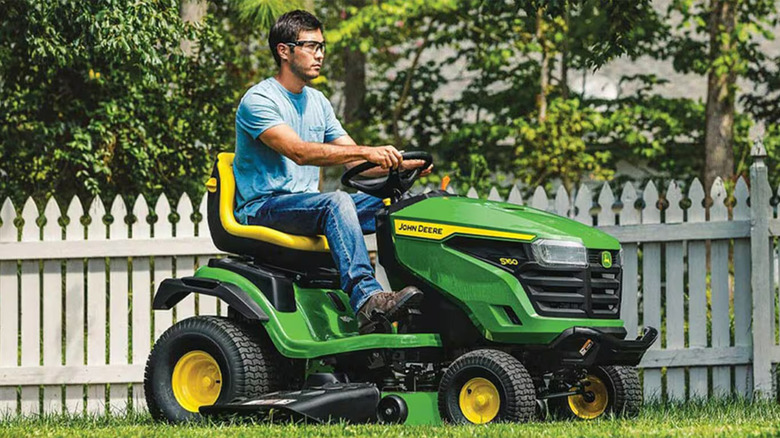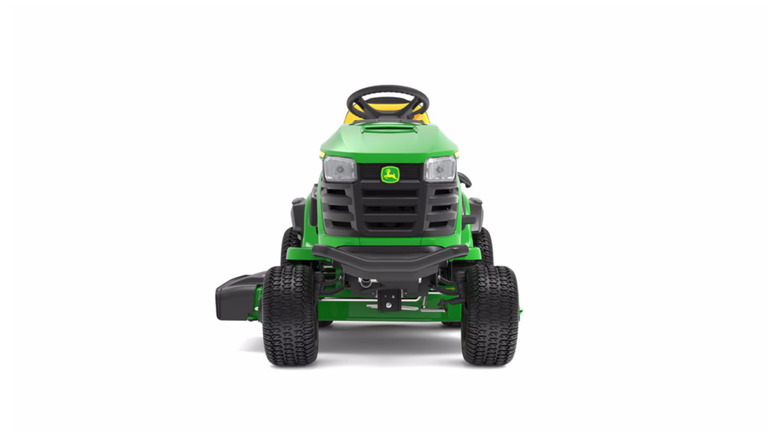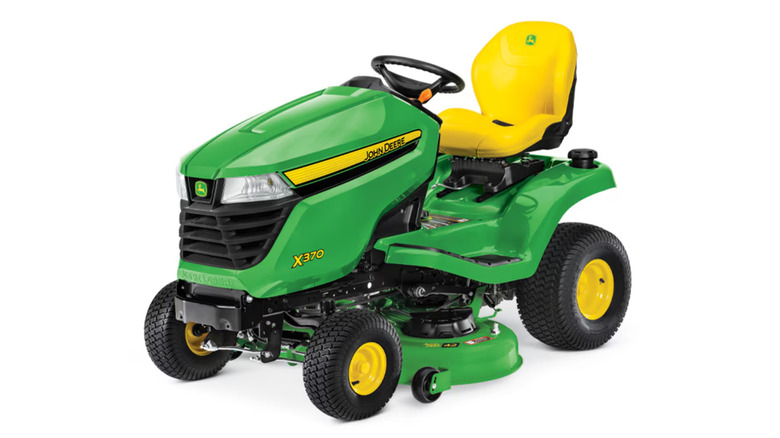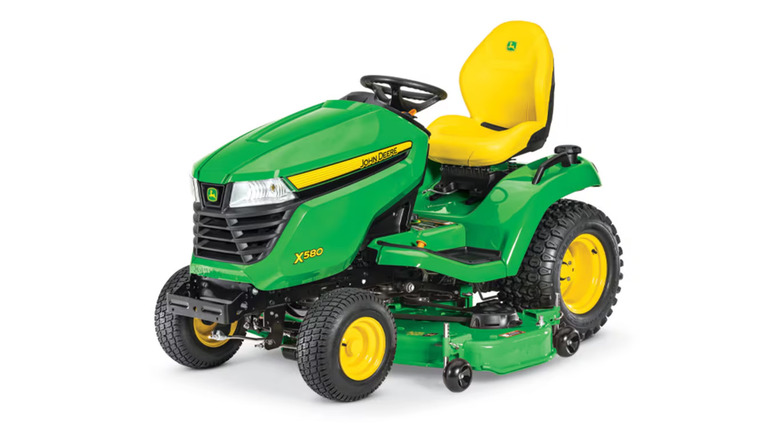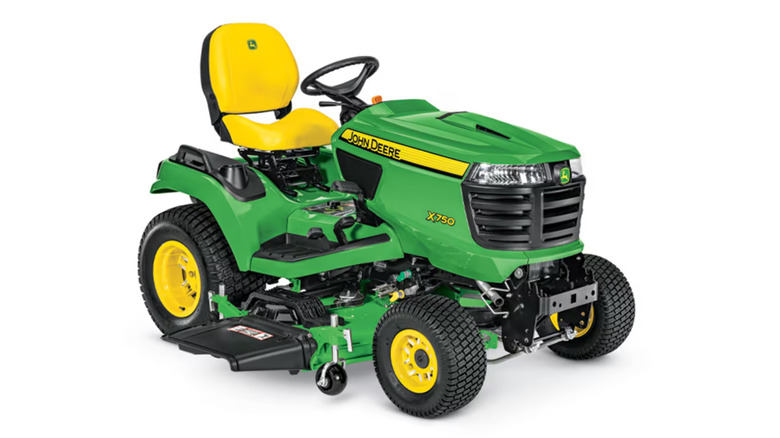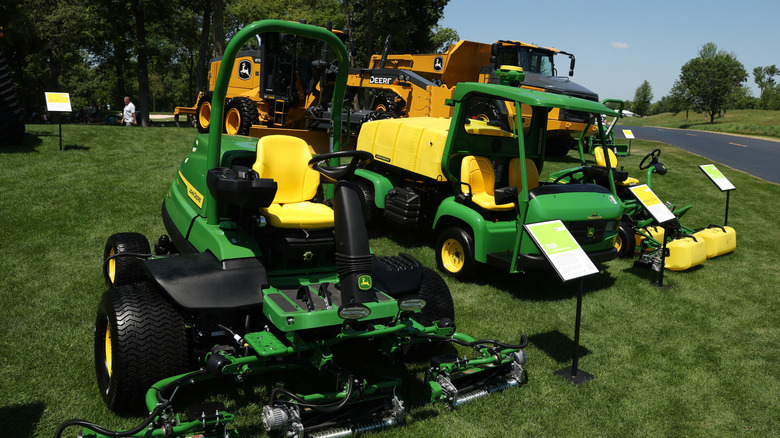5 Of The Best John Deere Riding Mowers, Ranked
John Deere is about as recognizable as it gets for lawn equipment and tractors. The brand started in 1837 and was founded by John Deere, inventor of the steel plow, which legend says was made out of a broken off saw blade. Years later, the company would adopt the iconic green and yellow color scheme, which the brand still uses today. Today, you can walk into virtually any big hardware chain and find the company's riding lawn mowers for sale.
As someone who owns a riding lawn mower, I know that the benefits are pretty nice. They can handle larger yards than push mowers, a boon for people with a large property. They also feature wider decks than a standard push mower, so you need fewer passes to cover the same area. As far as John Deere riding mowers go, there are a host of accessories and add-ons that let you do anything, from picking up leaves to removing snow. The add-ons can get pricey, but if you can afford them, they will turn your riding mower into a variety of tools.
If you're in the market for one of these mowers — be it because some John Deere products are made in the U.S. or because you like the brand — you have plenty of options. John Deere has five tiers of riding lawn mowers and over two dozen models in total. With so many options, it's easy to be overwhelmed, which is why we made this list of mowers. We hope our selection has what you were looking for.
John Deere S160
Let's start with the 100-series of lawn tractors, which are slightly different from lawn mowers. This is the brand's entry level tier and the series you'll often at places like Lowe's and Home Depot. There are eight models in this lineup that go from the S100 to the S180. At the low end, you're looking at about $2,400 for the base S100, which become $3,600 for the S180. While this isn't an easy choice, we believe the $3,200 S160 model might be the best option for most users. There are a few reasons behind this choice. For starters, all the mowers below the S160 in the series have a weaker 22-horsepower engine, whereas the S160 and higher get a 24-horsepower V-Twin Extended Life Series engine. Since these things can last a decade or longer, it's worth paying more for the slightly stronger engine with a longer lifespan.
There is one additional thing to consider: hills. If you live in a hilly area, you may want to step up to the S170, which comes with a stronger transmission. Users that have to deal with hillswill want a good transmission, since a cheaper one is more likely to burn out over years of intense, prolonged use. However, if you have hills steep enough to warrant a transmission upgrade, you may want to go with the John Deere X-series instead, since those machines are built for that type of terrain.
John Deere S240
If you have the means, stepping up from the S100 to the S200 series is a good idea. There are only two models in this tier: the S220 and S240. There is a bigger version of the S240, too, but the 48-inch model is pretty much identical to the 42-inch one. In any case, all models of the 200-series come with better hardware than the 100-series, while the price isn't much higher: The S220 goes for $3,000, while the S240 is $3,500.
We recommend skipping the S220 and going straight for the S240, which comes with a Kawasaki-built mower engine and a stronger transmission, while the S220 comes with a lower tier Briggs and Stratton engine. Users seem to prefer the S40, too, seeing as they consistently recommend it over the S220. Even customer reviews reflect this preference, with most being very happy with the more powerful riding mower. Sure, it costs an extra $500, but in this case, it's probably a worthwhile investment.
The other reason we'd recommend going for the S240 is because that same Kawasaki engine and transmission are featured in the mid-tier 300-series, which means that this machine can give you similar performances as a much more expensive product. Once you step up to the 300-series, you're starting to creep into the expensive prosumer territory. For reference, the cheapest 300-series mower with this engine, the X350, costs $4,000.
John Deere X370
From this point forward, everything we recommend is total overkill for an average suburban lot. This is where we start approaching professional stuff, specially designed for folks who have extremely large plots of land or may be starting a small landscaping business. There are a staggering 13 options in the John Deere X300-series, ranging from regular 42-inch and 48-inch decks to specialized models like the X350R, which comes with a built-in hopper. Picking one of these mowers for the article was pretty tough, since most of the lineup comes with the same engine and transmission options as the 200-series. Only the X380 and higher models feature a more powerful engine, but they are much more expensiveand come exclusively in larger deck sizes like 48-inch and 54-inch, while omitting some features found on cheaper models.
With all that in mind, we chose the X370 for this article. It comes with a relatively small 42-inch deck and the same engine and transmission as the S240, sure, but it adds some niceties, like a better seat and power steering. As you can imagine, power steering is extremely useful on a machine as heavy as this, and something we'd recommend looking into if you have a larger lot. There is only one caveat: If you intend to use your mower for demanding tasks like plowing snow, you'll want a stronger mower. We recommend skipping the X380 and going with the X390, since the X380 doesn't come with power steering.
John Deere X580
Stepping up to the X500-series changes things a little bit. Gone are the 42-inch deck options, replaced by mowers between 48 and 53 inches-long. For suburban homes, it would be like buying a semi-truck to take your kids to school. Sure, you can do it, but it's not a very good idea. In any case, these mowers are mostly made for people who have huge lawns, own a landscaping business, or really need the extra horsepower for steep hills or things like plowing snow. That's why we think that, if you need an X500-series mower at all, you should only consider the X580 and higher.
There are a few reasons for this. With the X580, you get the upgraded Kawasaki engine and K72 transmission, while keeping nice-to-have features like power steering, which the cheaper X500 units don't have. The 54-inch deck of the 580 is perfect for large land plots, and it's compatible with most John Deere attachments. This mower is a white whale for John Deere enthusiasts, as it's both extremely expensive and total overkill for most regular use cases. The X590 is technically better with a few small upgrades, but the X580 gets you 95% of the way there for about $1,000 cheaper.
Most of the upgrades found in the more expensive X500 models are nice to have, but they're not necessary. For example, stepping up to the X584 grants you four-wheel steer along with power steering, which can certainly be useful. With that in mind, the X580 is the best option in this price tier for most users.
John Deere X754
The X700 series is the top tier of John Deere lawn tractors, and we can only recommend it if you don't care about price at all or if you really need all this power and so many features. There are seven riding mowers in this lineup, starting with the X730 and moving up to the X758. Interestingly, the engine and transmission options in the lower tiers are the same as the higher tiers of the X500 series, while the higher-tier options come with a three-cylinder diesel engine.
Since we've seen that three-cylinder diesel engine being recommended over and over again, our pick for the X700 series is the X754. It's neither the cheapest nor the most expensive of the diesel engine models, and comes with plenty of features to increase comfort. It comes with four-wheel steer and four-wheel drive, giving you maximum agility. The foot pedals give you fine control over the engine, but the mower is also equipped with a cruise control function, which is nice to have if you're mowing long lines across a large plot of land.
Initially, we were going to recommend the X750, but when we saw how many users swear by four-wheel steer, which the 750 doesn't have, we decided to focus on the X754. With that said, if you're more comfortable with two-wheel steer (or want to cut about $1,200 off the price of this expensive machine), you might want to consider the X750, since the two are pretty much the same in every other way.
How we selected these riding mowers
Those John Deere riding mowers were chosen and ranked based on their features, which we analyzed through the brand's website. We selected one riding mower for every series available from the brand. As we wanted to avoid recommending two nearly-identical products, we tried our best to always pick something that was demonstrably different from the previous recommendation.
While we mostly based this list on the products' features, we also took into consideration professional reviews, Reddit and social media, and enthusiast forums, to see what users were recommending the most. For example, people who had owned both mowers recommended the S240 over the S220 in every forum post we checked. The only other consideration was attachments, but since most of the mowers in a given series are compatible with the same attachments, those extras didn't have a strong bearing on the ranking.
